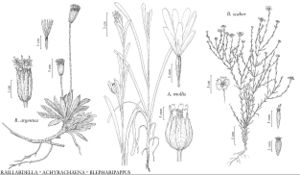Raillardella
Gen. Pl. 2: 442. 1873.
| Taxon | Illustrator ⠉ | |
|---|---|---|
 | Raillardella argentea Achyrachaena mollis Blepharipappus scaber | Bee F. Gunn Barbara Alongi Marjorie C. Leggitt |
Perennials, 1–50+ cm (with branching caudices or rhizomes). Stems ± erect (± scapiform). Leaves mostly basal (in rosettes); opposite; sessile; blades lanceolate or oblanceolate to linear, margins usually entire, sometimes, denticulate, faces glabrous or sericeous or sparsely hirtellous and/or stipitate-glandular. Heads radiate or discoid, borne singly (on scapiform peduncles) or rarely in open, ± corymbiform arrays. Peduncular bracts: (usually 0) pit-glands, tack-glands, and/or spines 0. Involucres hemispheric or campanulate to cylindric, 3–25+ mm diam. Phyllaries 0 (“involucres” then consisting of 1 series of paleae), or 1–13 in 1 series (lanceolate or oblanceolate to linear, herbaceous, each usually 1/2+ enveloping a subtended ray ovary, abaxially hirsute and ± stipitate-glandular). Receptacles flat or convex, glabrous or setulose, paleate (paleae ± persistent, usually in 1 series between rays and discs, peripheral and constituting “involucres” in discoid heads, connate or distinct, sometimes overlapping, herbaceous to scarious). Ray-florets 0 or 1–13, pistillate, fertile; corollas yellow to yellow-orange or orange to red-orange (not nerved with red to purple abaxially). Disc-florets 7–80+, bisexual, fertile; corollas concolorous with rays, tubes shorter than funnelform throats, lobes 5, deltate (anthers yellowish; styles glabrous proximal to branches). Ray cypselae ± terete, ± clavate, basal attachments central, apices not beaked, faces strigose; pappi 0, or of 8–30 ± subulate, ciliate to plumose scales. Disc cypselae ± terete, ± clavate, (basal attachments central, apices not beaked, faces strigose); pappi of 8–30 ± subulate, ciliate to plumose scales. x = 17 or 18.
Distribution
w United States
Discussion
Species 3 (3 in the flora).
Raillardella represents an early diverging lineage of tarweeds (Carlquist et al. 2003); putatively ancestral morphologic, ecologic, and chromosomal characteristics are shared with Arnica, the sister group of Madiinae (B. G. Baldwin and B. L. Wessa 2000). Two species that have been included in Raillardella are more closely related to other genera (e.g., Madia, B. G. Baldwin 1996) and are here treated as Anisocarpus scabridus and Carlquistia muirii.
Selected References
None.
Key
| 1 | Leaves of basal rosettes glabrous; ray florets 6–13, corollas orange to red-orange; disc florets45–80+ | Raillardella pringlei |
| 1 | Leaves of basal rosettes sericeous or stipitate-glandular; ray florets 0 or 1–7, corollas yellow to yellow-orange; disc florets 7–40+ | > 2 |
| 2 | Plants 1–15 cm; leaf blades sericeous (silvery), sometimes sparsely stipitate-glandular aswell; ray florets 0 | Raillardella argentea |
| 2 | Plants 6–50+ cm; leaf blades stipitate-glandular, sometimes sparsely hirtellous as well; ray florets 0 or 1–7 | Raillardella scaposa |